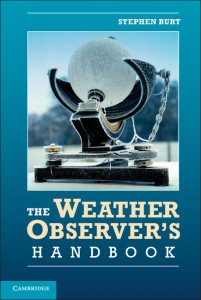
As a Brit, it’s traditional to believe that these cloudy and wet islands in the firing line of a succession of Atlantic storms are home to the most weather-obsessed nation on the planet. Not a bit of it, I’ve found; that title now definitely belongs to the U S of A.
Where’s my evidence? I’ve recently written a book The Weather Observer’s Handbook, which seeks to provide guidance to professional and amateur observers alike in the business of making and maintaining weather observations. ‘Measuring the weather’ is not as easy as it sounds – making accurate measurements that are comparable with the readings from other weather stations a county away, a continent away or a century ago demands careful attention to standards set out in rather dense officialese by the World Meteorological Organization in Geneva. Weather measurement standards and sensors have gone through a seismic change in the last two decades, as automatic computer-based weather stations have increasingly superseded human observers, sometimes with a decrease in the quality and reliability of the measurements as human oversight has been withdrawn, so an updated guide is timely.
My book is global in coverage, and this led me to look at the relative density of weather observations in different countries, which is just one index of how important ‘weather’ is seen to the nation’s government. In the United States, the latest count from the National Climatic Data Centre shows 10,406 weather observing locations, compared with only about 250 sites in the United Kingdom, for example. Even allowing for the differences in land area, network density is about 50 per cent higher in the United States than in the UK, and much higher still when considering only the difference in populations.
A recent paper in the Bulletin of the American Meteorological Society (April 2012*) brought this difference sharply into focus at a city scale. The authors looked at the heat island of the Phoenix metropolitan area in Arizona, using records from 70 weather stations within the city. The population of Phoenix in 2010 was 1.45 million (US Census figures). Compare this with London, which has a similar footprint (1572 km2 against 1338 km2 for Phoenix), but a much larger population of 7.75 million (2009 estimate). In London there are just eight ‘official’ weather stations covering the metropolis – one for every million souls, compared with one for every 20,000 city dwellers in Phoenix, a factor of 50 different.
There’s more subtle but practical evidence in a little-known National Oceanic and Atmospheric Administration (NOAA) programme for monitoring long-term (decades or longer) changes in climate. Objections have been made to observed trends in temperature and rainfall in the 20th century from existing weather station sites which may have been rural when they were first established, many in the mid- or late 19th century, but which are now urban or heavily suburban, and whose temperature records may have been affected by the growth of the urban envelope over the years. A decade ago, NOAA began to establish a national network of climate monitoring sites in locations chosen to be pristine or remote and from where observations could reasonably be expected to continue for at least several decades into the future. There are currently 126 of these sites across America, the US Climate Reference Network (USCRN), and more are planned. Using multiple-redundancy sensors and state-of-the-art logging and communications, the USCRN sites are already providing impeccable baseline data from which to benchmark changes in climate in the years to come. This quiet initiative is an exemplary long-term scientific monitoring programme, slowly being emulated by other countries around the world.
Perhaps even more revealing is the change in weather station numbers in recent decades. In the United States, today’s count of 10,406 locations is down only 10 per cent on the figure 30 years ago. In the United Kingdom, the network of 250 sites has declined 60 per cent since 1970.
Is the United Kingdom really still a nation ‘obsessed with the weather’? On the basis of evidence, perhaps that distinction really now belongs to the United States …
* Urban heat island research in Phoenix, Arizona by Winston Chow, Dean Brennan and Anthony Brazel: Bulletin of the American Meteorological Society, Vol. 93 (April 2012), pp 517-530
For more information on The Weather Observer’s Handbook and Stephen Burt, visit measuringtheweather.com
Latest Comments
Have your say!